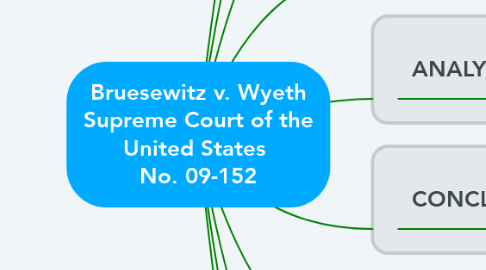
1. ISSUE
1.1. Whether the vaccine manufacturer shall be liable for damages arising from a vaccine-related injury if it resulted from side effects that were unavoidable even though the vaccine was properly prepared and was accompanied by proper directions and warnings? (2)
2. FACTS
2.1. Parties
2.1.1. Plaintiff: Russell Bruesewitz, et al.
2.1.2. Defendant: Wyeth, Inc., f.k.a. Wyeth Laboratories, et al.
2.2. What happened
2.2.1. In 1992, the petitioners' 6-months-old daughter, Hannah Bruesewitz, developed seizures after receiving a routine DTP vaccination and underwent lengthy hospitalization. She then developed debilitating residual seizure disorder and developmental delay requiring consistent care. (1)
2.2.1.1. In 1998, the vaccine manufacturere, Wyeth, took the DTP vaccine off the market.
2.3. Procedural history
2.3.1. In 1995, in conjunction with the National Childhood Vaccine Injury Act of 1986, the family petitioned the U.S. Court of Federal Claims for a compensation for Hannah's injuries. However, due to the regulatory changes, her injury was removed from the list of the vaccine-related adverse reactions eligible for the compensation, and the petition was rejected.
2.3.1.1. The family rejected the U.S. Court of Federal Claims decision and filed a lawsuit against Wyeth in the State Court in Pennsylvania, arging that the drug company failed to develop a "safer vaccine and should be held accountable for preventable injuries caused by the vaccine's defective design."
2.3.1.1.1. By the Wyeth's request, the case was heard by the U.S. District Court for the Eastern District of Pennsylvania and dismissed, as the federal judge held that the National Childhood Vaccine Injury Act protected Wyeth from lawsuits over vaccine injury claims.
2.3.1.1.2. The family appealed but the U.S. Court of Appeals for the 3rd Circuit affirmed the lower court decision.
2.3.1.1.3. The U.S. Supreme Court reviewed the case and upheld the ruling.
3. ISSUE BEFORE THE COURT
3.1. Does the federal law (NCVIA) protect vaccine manufacturers at the cost of children injured by the vaccine?
4. RULE OF LAW
4.1. National Childhood Vaccine Injury Act of 1986 (NCVIA)
5. ANALYSIS
5.1. The Plaintiff's Arguments
5.1.1. Vaccine manufacturer was supposed to offer a "safer" vaccine. Since the child developed seizure disorder and developmental issues, allegedly caused by the vaccine, the manufacturere should be hold responsible for the "defective <product> design."
5.2. The Defendant's Arguments
5.2.1. If the vaccine was approved by the Federal Drug Administraton, produced in accordance with the Good Manufacturing Practices, administered properly, and the recipient/family were informed of the possible adverse reaction, the vaccine manufacturers are not liable for the vaccine-related injury, beyond the provisions of NCVIA.
5.2.1.1. National Childhood Vaccine Act of 1986 preempts product liability laws.
5.3. Court ruling
5.3.1. The court rules in favor of Wyeth as NCVIA provides adequate protection to the victims of the vaccine-related injury and vaccine manufacturers are protected from the product liability claims.
6. CONCLUSION
6.1. The Supreme Court affirmed the decision of the lower court. Federal law preempts state law.
7. IMPACT
7.1. As any other drug, a vaccine can cause both expected and unexpected side effects. In the 80s, an avalanche of the civil cases against the vaccine manufacturers and significant settlements caused two of the major vaccine manufacturers to exit the market. The only remaining manufacturer was unable to meet the demand and there were cases of the childhood diseases preventable by the vaccinations. NCVIA was developed as a compromise and protected both the vaccine manufacturers and victims of the vaccine-related injuries.
7.1.1. "According to the CDC, from 2006 to 2016 over 3.1 billion doses of covered vaccines were distributed in the U.S. For petitions filed <in the "Vaccine Court" in this time period, 5,407 petitions were adjudicated by the Court, and of those 3,661 were compensated. This means for every 1 million doses of vaccine that were distributed, 1 individual was compensated. (HRSA)
8. IMPORTANCE
8.1. NCVIA paved a way for easy filing for compensation for the vaccine-related injuries. Since the Act includes "no-fault" clause, victims of the vaccine-related injuries do not have a burden of proving that the injury was indeed caused by the vaccine. Limited list of the vaccine-related adverse events allows to separate true claims from accidental and frivolous.
8.1.1. Vaccine manufacturers contribute to the compensations fund and enjoy protection from the civil lawsuits.
8.1.1.1. Remaining issue: was the injury or developmental delay truly caused by the vaccine or is it accidental? It is complicated. Vocal opponents of the vaccines claim that vaccinations cause autism and related disorders. This claim is difficult to support or disprove as childhood vaccinations frequently coincide with the milestones. Who can be sure that developmental delay manifested at 6 or 12 months of age is caused by the drug or was noted because the child was lagging behind? More research is needed, both clinical and experiential.
